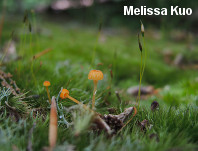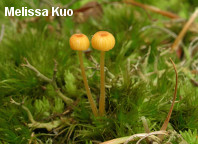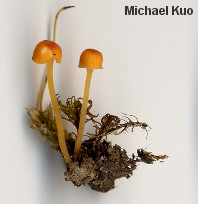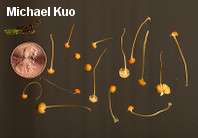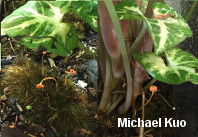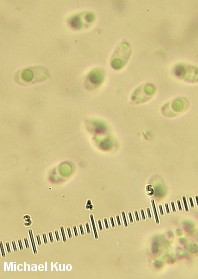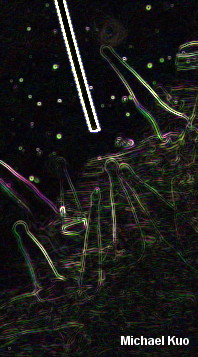| Major Groups > Gilled Mushrooms > Pale-Spored > Mycenoid | Omphalinoid > Rickenella fibula |

|
Rickenella fibula [ Basidiomycota > Agaricales > Uncertain > Rickenella . . . ] by Michael Kuo This tiny little mushroom has a thing for moss—in woodland settings and even in commercial "Frog Moss" used in terrariums and vivariums (see the illustration). Rickenella fibula can be found across North America, and its features include orange colors, a cap that is blocky at first but soon becomes convex, pale gills that run down the stem, and distinctive microscopic features; it is virtually bristling with sterile structures known as "cystidia," on its cap, gills, and upper stem. In my area, Rickenella fibula is often a springtime species, appearing during late morel Look-alikes are numerous. The fact that the gills run deeply down the stem will separate Rickenella fibula from most marasmioid and mycenoid contenders—and the penchant for moss will help to separate it from Xeromphalina kauffmanii and Xeromphalina campanella, which grow in dense clusters (often numbering in the hundreds) on deadwood. Also compare Rickenella fibula with Cantharellus minor and Hygrocybe cantharellus, which are usually a bit larger than Rickenella fibula. Description: Ecology: Probably saprobic but apparently involved in some sort of mutualism with moss; growing alone, scattered, or gregariously in moss beds; spring through fall, or over winter in warm climates; widely distributed in North America. The illustrated and described collections are from Illinois. Cap: 2–10 mm across; blocky or squarish at first, becoming convex, then broadly convex, with or without a shallow central depression; tacky when fresh but soon dry; bald or, with a hand lens, very finely hairy; the margin translucent-lined by maturity; orange with a whitish margin when fresh and young; soon fading to yellowish orange overall, with a darker orange center. Gills: Running deeply down the stem; distant or nearly so; short-gills in several tiers; creamy or very pale orange. Stem: 5–45 mm long; 0.5–1.5 mm thick; equal; dry; bald; colored like the cap; basal mycelium white. Flesh: Insubstantial; pale. Odor and Taste: Not distinctive Chemical Reactions: KOH negative on cap surface. Spore Print: White. Microscopic Features: Spores 3–4 x 1.5–2.5 µm; ellipsoid; smooth; hyaline and 1- to 3-guttulate in KOH; inamyloid. Cheilocystidia and pleurocystidia 25–40 x 5–7.5 µm; fusiform with tapered or subcapitate apices; thin-walled; hyaline in KOH; smooth. Pileipellis a tightly packed cutis with numerous pileocystidia 50–100 x 7.5–12.5 µm, fusiform with wide bases and tapered, subcapitate, or capitate apices, thin-walled, smooth, hyaline in KOH. REFERENCES: (Bulliard, 1780) Raithelhuber, 1973. (Fries, 1821; Saccardo, 1887; Kauffman, 1916; Smith, 1947; Phillips, 1991/2005; Lincoff, 1992; Barron, 1999; McNeil, 2006; Miller & Miller, 2006; Trudell & Ammirati, 2009; Kuo & Methven, 2014; Desjardin, Wood & Stevens, 2015.) Herb. Kuo 05169501, 05260302, 05040702, 05061201, 01231601. This site contains no information about the edibility or toxicity of mushrooms. |
© MushroomExpert.Com |
|
Cite this page as: Kuo, M. (2016, January). Rickenella fibula. Retrieved from the MushroomExpert.Com Web site: http://www.mushroomexpert.com/rickenella_fibula.html |
